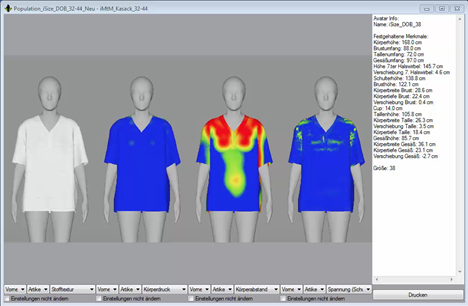Efficient virtual garment fit evaluation infrastructure based on synthetic avatar target customer groups for MtM application
DOI:
https://doi.org/10.25367/cdatp.2020.1.p160-169Keywords:
mass customization, test population, target group, sizing and fit, fit control, 3D simulation, virtual product developmentAbstract
Customization becomes more and more popular and influences the product development process in apparel industry. In addition to individualized products, the fit of garments is very important for the customization. Numerous tools are used to take the right measurements, to transport individual posture information and to implement these data correctly into a product pattern based on a predefined construction system. Unfortunately, in most cases the mass customization process takes place without a fitting session. Usually fit and design will be checked in the last process step, when the product is already manufactured. Virtual product development is a powerful tool to change this process getting an early fit and design check. By using a test population representing the target group, it is possible to check the sizing and to screen the fit of a product on individual bodies and postures in a short time. In a joint project between the Virtual Lab of Niederrhein University of Applied Sciences and Avalution GmbH, a practical approach for the implementation of a fitting session to a mass customization product development process was developed. The entire process has a three-level structure: First, the avatar population is built up using garment specific body measurements. Connected to a 3D simulation program, an automatic process of determining the made-to-measure (MtM) values, carrying out the MtM grading and the fitting on the selected avatar are initiated. In a special application, the digital try-ons are finally output as images in different physical aspects for evaluation.
References
Ernst, M.; Detering-Koll, U. Posture Dependency of 3D-Body Scanning Data for a Virtual Product Development Process. In Proc. of 5th International Conference on 3D Body Scanning Technologies, Lugano, Switzerland, 21-22 October 2014.
Löffler-Wirth, H. Body typing of the adult population of Leipzig. Application forum Human Solutions. Kaiserslautern, Germany, 21 April 2016.
Vidya, Assyst. Available online: https://www.assyst.de/de/produkte/3d-vidya/index.html (accessed on February 19, 2020)
SizeGERMANY – Startseite’. Available online: https://portal.sizegermany.de/SizeGermany/pages/home.seam (accessed on February 19, 2020).
Fischer, T.; Artschwager, A.; Pfleiderer, K.; Rissiek, A.; Mandalka, M.; Seidl, A.; Trieb, R. Automatic morphological classification with Case-Based Reasoning. 7th International Conference on 3D Body Scanning Technologies. Lugano, Switzerland, 30 Nov. – 1 Dec. 2016.
Ernst, M.; Detering-Koll, U. Investigation on Body shaping Structures Using Body Scanning Technology and 3D Simulation Tools. In Proc. of 3nd International Conference on 3D Body Scanning Technologies, Lugano, Switzerland, 16-17 October 2012.
Ernst, M. Next generation of product development – obtaining 3D buy-in, building capability and generating a fruitful roadmap. PI Conference Berlin, Germany, 5-6 October 2016.
Ernst, M.; Böhm, M.; Detering-Koll, U. Rapid body scanning technology for a virtual mass customization process in garment industry. In Proc. of 7th International Conference on 3D Body Scanning Technologies, Lugano, Switzerland, 30 Nov. – 1 Dec. 2016.
Allen, B.; Curless, B.; Popovic, Z. The space of human body shapes: reconstruction and parameterization from range scans. In Proc. of SIGGRAPH '03 ACM SIGGRAPH 2003 Papers, 587-594, San Diego, California: ACM New York.
Blanz, V.; Vetter, T. A morphable model for the synthesis of 3D faces. In Proceedings of ACM SIGGRAPH 99, 187–194, 1999.
Praun, E.; Sweldens, W.; Schröder, P. Consistent mesh parameterizations. In Proceedings of ACM SIGGRAPH 2001, 179–184. New York: ACM Press/ACMSIGGRAPH.
Turk, M.; Pentland, A. Eigenfaces for recognition. Journal of Cognitive Neuroscience, 1991, 3 (1), 71-86. DOI: 10.1162/jocn.1991.3.1.71.

Downloads
Published
How to Cite
Issue
Section
License
Copyright (c) 2020 Antje Christophersen

This work is licensed under a Creative Commons Attribution-NonCommercial-NoDerivatives 4.0 International License.





